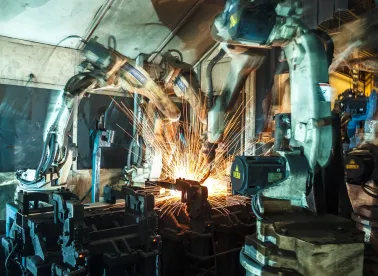No two manufacturers are alike. Every company has its own assembly line configurations, floorplans and logistical challenges. It stands to reason that each employer has had a different experience adjusting and adapting to the coronavirus pandemic. But one thing that manufacturers have in common is an inability to go 100 percent virtual.
We can learn from the experiences of manufacturers to determine the best ways to deal with common problems tied to COVID-19, including absenteeism and line shutdowns, while gaining a better understanding of what adjustments are temporary — and what changes are here to stay.
What Are Manufacturers Doing?
Social distancing, particularly in older manufacturing facilities, is a big issue. Spacing issues have forced a number of employers to be creative with the design of their assembly lines. The key has been to balance personal space and employee safety with business continuity. For many, it is easier said than done.
Some manufacturers had to prioritize the production of certain products to make their layouts work. Processes and routines have been adjusted to account for illnesses. Coronavirus testing has been increased to limit coronavirus spread.
Technology has changed how manufacturers interact, along with how they handle information, production, and inventory. Virtual salesfloors, showrooms and summits are concepts were extremely rare just a year ago. People are coming up with new and better ways to use technology — that should continue to influence the production side of manufacturing for years to come.
Changes and Challenges to the Supply Chain
COVID-19 exposed a number of weaknesses within the American supply chain, including delays getting overseas goods into the country. Some companies have reported issues that include shortages of shipping containers, fluctuating shipping costs, and bottlenecks at ports.
Such issues have proven problematic for many manufacturers and retailers, particularly those where margins were already tight. Manufacturers that had perfected just-in-time production found themselves short on supply at a time when it was beneficial to have extra inventory to meet a spike in demand and consumer expectations of instantaneous delivery.
Home ordering was an initial boon for some manufacturers, but frustration set in as more people, feeling increasingly shut in, wanted faster delivery of goods but were forced to wait as manufacturers and retailers coped with inefficient processes. Many faced a perfect storm of instability on the supply side and lofty expectations on the demand side.
To be sure, creative companies find ways to fill the gaps whenever a system shows signs of weakness. Technology is one way manufacturers have addressed these shortcomings.
We expect changes to how U.S. companies visualize and design their supply chains. One potential solution involves bringing more production to the western hemisphere, given the length of time it takes to ship items made in Asia or Europe. Other manufacturers are increasing the size and location of inventories, including the use of “safety stocks” of key materials.
Many manufacturers are talking about establishing facilities in North America — and encouraging their suppliers to do the same. A revival of backyard manufacturing is a possibility. Manufacturers could also look to double or triple the size of their distribution facilities or trucking fleets to compress time of delivery.
We expect changes to how U.S. companies visualize and design their supply chains. One potential solution involves bringing more production to the western hemisphere, given the length of time it takes to ship items made in Asia or Europe.
Addressing Transportation Waste
More manufacturers are discussing the importance of limiting “transportation waste,” or the unnecessary movement of parts or double handling of materials. Think of a company that moves a product to different facilities as it is being assembled. To tackle this issue, more manufacturers are analyzing their systems to find efficiencies with the supply chain and delivery channels. The goal is to eradicate unnecessary steps and streamline production.
More manufacturers are discussing the importance of limiting “transportation waste,” or the unnecessary movement of parts or double handling of materials. Think of a company that moves a product to different facilities as it is being assembled. To tackle this issue, more manufacturers are analyzing their systems to find efficiencies with the supply chain and delivery channels.
Another form of transportation waste stems from the millions of Americans who are ordering the bulk of their goods from home. Shipping a bulk order of items to one location for distribution is being replaced by a model where items are being mailed to a multitude of residential addresses.
Where Do We Go From Here?
The future of manufacturing hinges greatly on the uncertainty of the pandemic. Trying to project new horizons is the greatest challenge for manufacturers going forward. Innovation will eventually find a way to minimize backlogs, and lessons learned from 2020 will allow producers to address shortcomings in the supply chain and delivery systems.
Certain industries will rebound faster than others. Furniture companies, overwhelmed by “staycation” orders, will find a way to meet demand. Manufacturers that produce items for the hospitality or restaurant industries will continue to face challenges until things normalize. Predictions are that air travel may not return to pre-pandemic levels until 2024, placing continued pressure on the aerospace industry.
Will people be eager to leave their homes when vaccines are widely distributed, or will hesitancy linger for a while longer? That is a question that cannot be answered at this time.
There will be systemic changes. The Amazon model is driving consumer expectations, which in turn is forcing more manufacturers and retailers to assess and permanently adjust their operating models. Expect more production closer to home and for manufacturers to use larger facilities to streamline operations and reduce transportation waste. Technology will be used more and more.
Successful businesses will focus on the safety of their employees and delivering quality products and services to customers. While the world itself hasn’t changed that much, we are seeing changes in how companies protect workers and meet customer expectations. All manufacturers must be ready to adapt as the world reopens.






 />i
/>i

